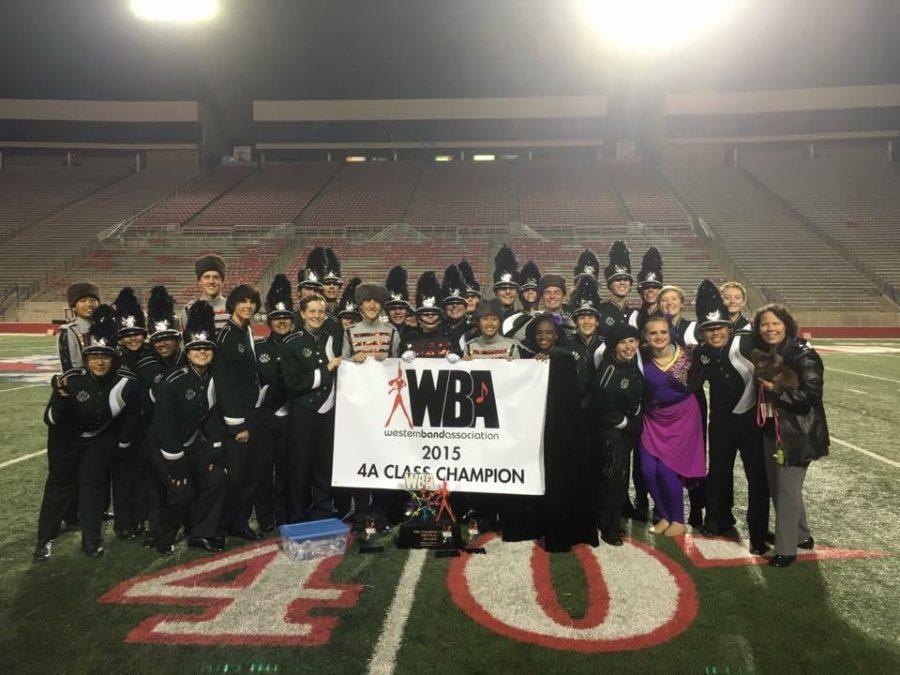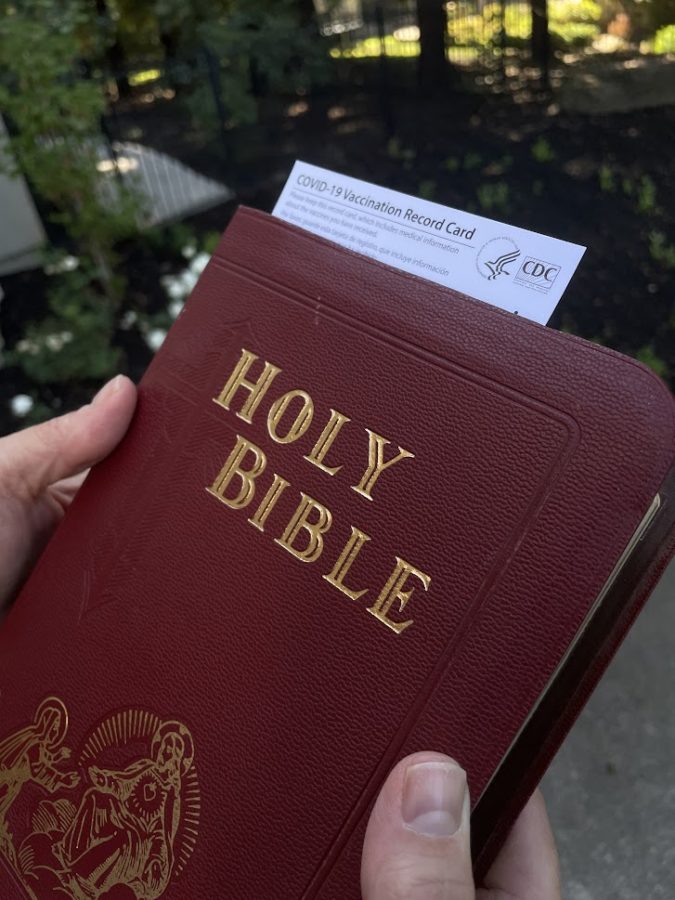The Emerald Brigade, one of the most highly decorated organizations on the Granite Bay High School campus, has finished off their marching season on a high note – on Nov. 21 at the Western Band Association Class Championship, after competing alongside 20 other similarly-sized bands, they took first place. The group then went on to a second day of competition, where their score improved at the WBA Grand Championship. On Nov. 22, the Emerald Brigade finished in fifth out of the 16 top-scoring bands from the previous day’s competition, the highest placement ever achieved by GBHS.
The roughly 130 membered band competed at the Fresno State Bulldog Stadium that Saturday in the 4A Class Championship, where divisions are determined according to a band’s population – in 4A band size ranges from 90 to 140 members. Sunday, at the Grand Championship, the 16 highest-scoring bands from all five divisions competed again – regardless of size – where scores were recalculated in the chance that the performance improves, and, in the Emerald Brigade’s case, it did.
“Sunday, we rehearsed … in the morning (and) performed again so (that) they can reevaluate and see if maybe you did better, and we did even better the second day score-wise and beat the bands we wanted to (beat),” senior, tuba player, freshmen representative, unofficial tuba section leader and four year Emerald Brigade member Sara Fassler said. “We took fifth, which Granite Bay (High School) has never done. Getting first (on Saturday) is just a shock to us, I still can’t believe it. Every single year I’ve marched, we go and we get like fourth, third maybe, if we’re lucky, one time we got second, but we’ve never come out (being) the best band in a division.”
The admirable win and rank was accomplished at the end of a nearly four month marching season. The road to victory is time-consuming and strenuous, but according to Fassler, the commitment is “so worth it” having finished so successfully.
Starting not at the beginning of the school year, but during the last few weeks of summer, freshmen and new members are taught about commands, starting with the left foot while marching, pointing their toes up when moving forward and other tips and tricks necessary for marching cohesively. The last week of summer is All-Member Band Camp, where the entire Emerald Brigade begins their marching season.
Freshman trumpet player Sam Roberts said it was a little stressful to learn how to march because marching is the opposite of how your body has been trained to move, so it feels unnatural. After the camps, before the start of school, however, he said he felt “a lot better” about his marching abilities.
Taking time from their summer breaks is just one of many time commitments required as a member of the Emerald Brigade.
“Every day except Wednesdays, we have zero period rehearsal, where we have to be ready for practice on the field at 6:45 in the morning, and we practice until school starts,” said senior and Head Drum Major Emalyn Atkins. “Monday nights we start at 6:30 p.m. and practice until 9:00 p.m. and we also practice every day during second period. The percussion and color guard have additional practices on Wednesday night and Thursday night, respectively. Overall, (starting) from band camp, the wind members practiced 16,775 minutes, not including individual practices or sectionals, and percussion and guard practiced 18,395.”
Band members have ‘Super Saturdays’ every Saturday that is not a competition day. On those days, practice starts at 9:00 a.m. and ends at either 9:00 p.m. or 6:00 p.m.. On Saturdays where the band has a competition, rehearsals beforehand can take as long as four hours, followed by a transportation to the school and then a two hour warm up, finished, finally, by the band’s actual performance.
During first period, the color guard and percussion members practice on the field, and during second period the rest of the instrumental sections practice.
The three groups which make up the Emerald Brigade are the winds, the color guard and the percussion. In the winds, there are around ten instrumental groups, which include the flute, clarinet, double reeds – oboe and bassoon – saxophone, trumpet, french horn, trombone, baritone, tuba and percussion. Percussion is split into two sections: the drumline, which marches, and the pit, which remains standing throughout the performance at the front. Additionally, peasants which were used in this year’s performance, were volunteers from around the school who offered their time to attend practices and perform in competitions.
Furthermore, different versions of instruments are used depending on the season. For example, during the marching season, the sousaphone is played, which wraps around the player’s waist, while during concert season, the tuba – which is technically the same instrument – is played instead.
While the student’s time investment is large, there are many behind-the-scene activities that sometimes go unrecognized. Lynn Lewis, GBHS’ Band Director, works with other staff members to select the composer, theme, music, choreography and set design of the performance.
“We have a really great staff that helps out a lot,” Lewis said. “We have a staff that writes the drum music, we have a staff that writes the (color guard choreography, so) it’s a big, big, big process. We listen to the music. Soft, pretty music (will) change what we write – we’re not going to (choreograph) harsh lines or angles for something that’s soft and pretty, we’ll write something that’s really flowy so that it adds to the music. It’s one of the only art forms that has visual and audio at the same time.”
This year’s performance was based on the Russian Revolution of 1905, or ‘Bloody Sunday.’ Parents constructed a 35 foot replica of the historic Alexander Column, which stood above the square in St. Petersburg where the massacre occurred.
“I don’t know too much about the design or creation of our shows because the process is largely kept a secret,” Atkins said. “From what I understand, Mrs. Lewis starts planning in the spring semester with the rest of our staff and they brainstorm on how to make us look our best the next year. Generally, they have a sort of storyline behind them. This year, our show was about the Russian Revolution of 1905, and the music was by Russian composer Shostakovich, with a few pieces from the movie Anastasia and another by Eric Whitacre.”
In addition to the band’s supervision under Lewis and its help from many other staff members, the Emerald Brigade receives guidance from students in Leadership. As President, senior trombone player Trey Armstrong said his responsibilities range from leading the class on days when Lewis is absent to leading the Leadership meetings.
“(Leadership is) the driving force in keeping things (and) the atmosphere positive in the program,” Lewis said. “They set the example, so how hard they work sets the example for how hard everybody else works. If we don’t do as well, then they help people deal with that, (and decide) how to approach (a situation). They’re leading the other kids, and it’s a really, really important group of kids and they’ve done a great job this year so far.”
One competition, a new one which the Emerald Brigade had not ever performed at, the Emerald Brigade didn’t place. Fassler said that competition served as a wake-up call and reality check, which motivated them to practice even harder.
Perhaps it was this competition which instilled a determination in the group, reflecting their future victory.
“From where they started in August, with a lot of freshmen coming in and … not being able to do anything, to being as good as they were on that weekend … is incredible,” Lewis said. “They peaked at exactly the right time and everybody was in sync together. I think I am more proud of these kids than any other year because of where they started. Everybody worked really hard.”
“These kids really did work hard, and it probably (is noteworthy) that their experience was different because a lot of the other bands go and stay in a motel, (but) we stayed on a gym floor. The school we were at didn’t have hot water and it was really cold at night (because) the heater didn’t work in the gym. (But) they didn’t complain, we just (said) ‘okay, this is something else we have to overcome.’ They had a really good weekend and it paid off.”
The weekend of the WBA Championships was unique for both Fassler and Roberts, the former who had a torn ACL and the latter who had a torn ACL and MCL.
Fassler was able to perform in the majority of the show, sitting out only for a small part which she could not do, with her injury. Roberts acted as a peasant in the show, and said the experience was an enjoyable one.
“I want to see, in the years that I’m here, if we can place higher,” Roberts said. “I want to work a lot harder at the shows we’re doing. That’s one of my goals, to place better or just as well as we did (again).”
The collaborative dedication, determination and commitment of the entire Emerald Brigade truly paid off.
“I loved championships,” freshman color guard member Kristina Rodriguez said. “It was super fun and exciting, but there was also a sense of melancholy in the air. This was our last weekend in the season, our last performance of this show (and) the seniors very last show.”
“When we won first in our division, everything was chaotic. People were crying or screaming or cheering. Nobody calmed down for a while. What we had done was big, and after a season of many ups and downs, we were proud to be able to say that we won first. The medals were just made of material, but the best part was being able to say that WE did it, by OURSELVES.”















